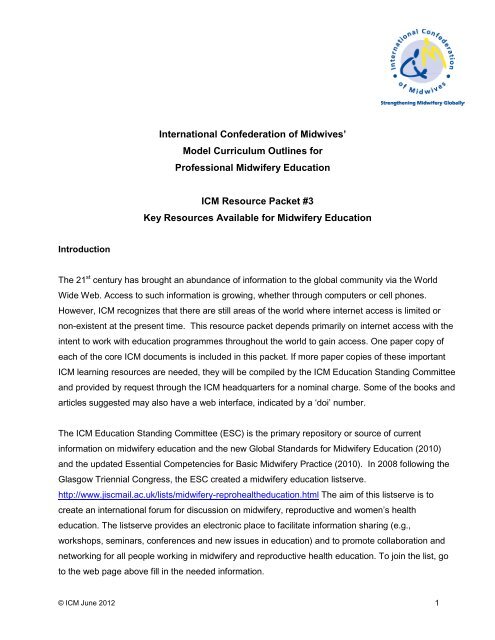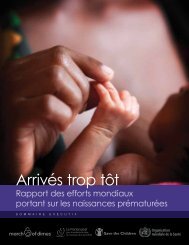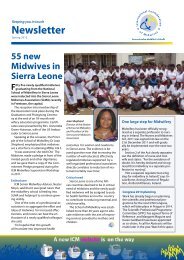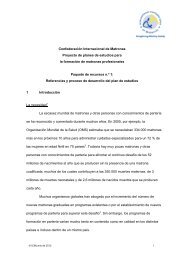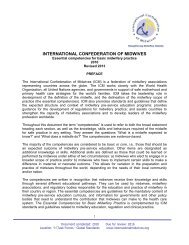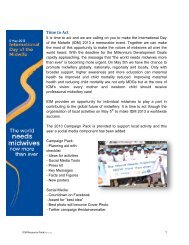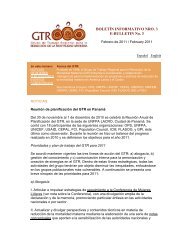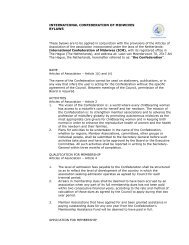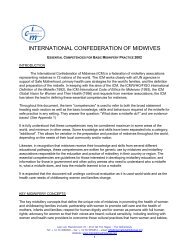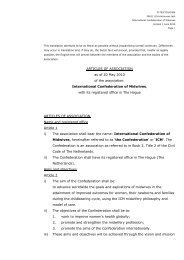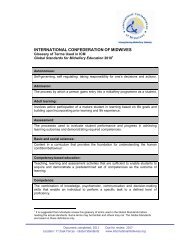Key Resources Available for Midwifery Education - International ...
Key Resources Available for Midwifery Education - International ...
Key Resources Available for Midwifery Education - International ...
Create successful ePaper yourself
Turn your PDF publications into a flip-book with our unique Google optimized e-Paper software.
<strong>International</strong> Confederation of Midwives’Model Curriculum Outlines <strong>for</strong>Professional <strong>Midwifery</strong> <strong>Education</strong>ICM Resource Packet #3<strong>Key</strong> <strong>Resources</strong> <strong>Available</strong> <strong>for</strong> <strong>Midwifery</strong> <strong>Education</strong>IntroductionThe 21 st century has brought an abundance of in<strong>for</strong>mation to the global community via the WorldWide Web. Access to such in<strong>for</strong>mation is growing, whether through computers or cell phones.However, ICM recognizes that there are still areas of the world where internet access is limited ornon-existent at the present time. This resource packet depends primarily on internet access with theintent to work with education programmes throughout the world to gain access. One paper copy ofeach of the core ICM documents is included in this packet. If more paper copies of these importantICM learning resources are needed, they will be compiled by the ICM <strong>Education</strong> Standing Committeeand provided by request through the ICM headquarters <strong>for</strong> a nominal charge. Some of the books andarticles suggested may also have a web interface, indicated by a ‘doi’ number.The ICM <strong>Education</strong> Standing Committee (ESC) is the primary repository or source of currentin<strong>for</strong>mation on midwifery education and the new Global Standards <strong>for</strong> <strong>Midwifery</strong> <strong>Education</strong> (2010)and the updated Essential Competencies <strong>for</strong> Basic <strong>Midwifery</strong> Practice (2010). In 2008 following theGlasgow Triennial Congress, the ESC created a midwifery education listserve.http://www.jiscmail.ac.uk/lists/midwifery-reprohealtheducation.html The aim of this listserve is tocreate an international <strong>for</strong>um <strong>for</strong> discussion on midwifery, reproductive and women’s healtheducation. The listserve provides an electronic place to facilitate in<strong>for</strong>mation sharing (e.g.,workshops, seminars, conferences and new issues in education) and to promote collaboration andnetworking <strong>for</strong> all people working in midwifery and reproductive health education. To join the list, goto the web page above fill in the needed in<strong>for</strong>mation.© ICM June 2012 1
nurses and midwives (2009).Returning to “Health topics” you can click on ‘Pregnancy’ where you can locate Making PregnancySafer documents from the ‘document centre’ listing on left side of screen. Clicking on “Programmesand Projects” will bring up access to the Reproductive Health Library (RHL) with a variety of onlineresources <strong>for</strong> care during the reproductive years, including childbirth. You can also locate the WHOreproductive health competencies.WHO has also published guidelines <strong>for</strong> Basic and Comprehensive Emergency Obstetric Care, andmore recently added Neonatal care (BEmONC). Guidelines <strong>for</strong> prevention and management ofpostpartum haemorrhage and pre-eclampsia/eclampsia are also available online.<strong>Midwifery</strong> educators in low resource countries with WHO offices can visit these offices to obtain suchresources. WHO country offices may also provide grants to education programmes to purchaseteaching materials, including texts and plastic or cloth models.Partnership <strong>for</strong> Maternal, Newborn, and Child Health (PMNCH)WHO is the host of the Partnership <strong>for</strong> Maternal, Newborn and Child Health (PMNCH), a globaladvocacy group <strong>for</strong> improving the health of women, newborns and children, especially in resourcepoor nations. The website at www.who.int/pmnch/en includes a variety of in<strong>for</strong>mation on partneractivities. Visit the PMNCH knowledge portal that includes Knowledge Summaries that synthesize thescientific evidence in short, user-friendly <strong>for</strong>mat to in<strong>for</strong>m MNC policy and practice. Of special interestto midwifery education is Knowledge Summary #14: Save Lives: Invest in Midwives athttp://portal.pmnch.org/knowledge-summaries/ks14United Nations Children’s Fund (Unicef)Unicef is an international organization dedicated to the health and well-being of children from birththrough adolescence. As noted on their website, About UNICEF: Who are we, “UNICEF is the driving<strong>for</strong>ce that helps build a world where the rights of every child are realized. We have the global© ICM June 2012 3
authority to influence decision-makers, and the variety of partners at grassroots level t turn the mostinnovative ideas into reality.” www.unicef.orgUnicef recognizes the importance of healthy pregnancies contributing to healthy babies, andthere<strong>for</strong>e is interested in quality midwifery care.Unicef offices in low resource countries can provide resources at country level on breastfeeding andimmunization programmes, among others. When visiting the website, go to “Focus areas” and clickon ‘Mothers & Babies’ or other areas such as ‘Nutrition’.United Nations Fund <strong>for</strong> Population Advancement (UNFPA)UNFPA is an international organization dedicated to reproductive health, women’s rights, andreduction of maternal and neonatal morbidity and mortality. It works in partnership with manyagencies, including the <strong>International</strong> Confederation of Midwives. The website includes in<strong>for</strong>mation onmany related topics. To find the specific in<strong>for</strong>mation related to midwives, begin on the home page atwww.unfpa.org and then click on Reproductive Health along left side of screen, then click on SafeMotherhood, followed by clicking on Midwives. This site includes reports, updated resource material,and videos exploring the need <strong>for</strong> and roles of midwives in the world.<strong>Midwifery</strong> educators in low resource countries can visit the UNFPA country office to obtain many ofthe resources found on the website.United States Agency <strong>for</strong> <strong>International</strong> Development (USAID)This is the U.S. <strong>for</strong>eign aid agency with interest in a variety of health topics, Visit the website atwww.usaid.gov and clip on Our Work, then Health, then Maternal Child, then Maternal Health to viewsome of resources and activities sponsored by this agency. One of their newest projects is HelpingBabies Breathe (HBB).USAID partnered with IntraHealth <strong>International</strong> in 2007 to publish the following manual:© ICM June 2012 4
IntraHealth <strong>International</strong>, USAID. (2007). Learning <strong>for</strong> per<strong>for</strong>mance: A guide and toolkit <strong>for</strong> healthworker training and education programs. Washington, DC: The Capacity Project.www.capacityproject.org under Publications and <strong>Resources</strong> click tools & resources <strong>for</strong> HRHpractitioner. You will find the manual in English, French and Spanish.USAID Maternal and Child Health Integrated Program (MCHIP)MCHIP, funded through USAID, provides a website at www.mchip.net that has many electronicreferences <strong>for</strong> care during childbearing and family planning as well as health professional education.Click on “Tools & <strong>Resources</strong>” and then look under Topics/subtypes. Look under ‘Browse related links’to explore the various partnerships they are involved in that focus on maternal and newborn health.Clicking on any one of these related links takes you directly to that website where further resourcesare located.K4Health (Knowledge <strong>for</strong> Health)www.k4health.org After exploring the home page <strong>for</strong> the variety of resources this site offers, click on“etoolkits’ and “elearning” to locate a variety of learning and teaching resources related tochildbearing and reproductive health. For example, the postpartum haemorrhage toolkit has a videodemonstrating active management of the third stage of labour (AMTSL).Under www.k4health.org/toolkits/pse click on the Pre-service <strong>Education</strong> Program Roadmap and youwill find the seven (7) steps <strong>for</strong> designing, implementing , monitoring and evaluating a pre-serviceeducation program focused on health workers needed to provide maternal and newborn health care.This site also has an extensive electronic library of resources.Jhpiego, an affiliate of Johns Hopkins UniversityJhpiego has a long history of producing health-oriented training materials, including thepreparation of health professionals. Peruse the website as www.jhpiego.org and follow link toTraining Materials found under <strong>Resources</strong>.© ICM June 2012 5
Review of <strong>Midwifery</strong> Curricula OnlineThere are many pre-service midwifery education programmes throughout the world that use awebsite to in<strong>for</strong>m potential candidates and regulatory bodies of what they include in their midwiferycurriculum, including a description of the content of the courses. Examples include:Department of <strong>Midwifery</strong> at Bastyr University in Seattle, Washington that offers a 3-year directentry midwifery programme. Http://www.seattlemidwifery.org/midwifery-education/curriculumoverviewUniversity of Pennsylvania School of Nursing master’s programme in midwifery post-nursing at:http://www.nursing.upenn.edu/academic_programs/grad/masters/program_detail.asp?prid=10Suggested Books & Articles<strong>Resources</strong> <strong>for</strong> Adult Learning1. Brookfield SD & Holst JD. Radicalizing learning: Adult education <strong>for</strong> a just world. SanFrancisco: Jossey-Bass, 2011. Chapter 2: Understanding adult learning, pp. 2 – 42. Thischapter is good overview of the ways adults learn in contemporary societies. They includetrans<strong>for</strong>mative learning, self-directed learning, and critical reflection.2. Knowles MS, Holton EF, Swanson RA. The adult learner 6 th edition. Boston: Elsevier,2005.3. Paul R. Critical thinking, moral integrity, and citizenship: Teaching <strong>for</strong> the intellectualvirtues, 1993. http://www.criticalthinking.org/resources/articles/ct-moral-integrity.shtml4. Paul R, Elder L. The miniature guide to critical thinking concepts and tools. The Foundation<strong>for</strong> Critical Thinking www.criticalthinking.org5. Pritchard A. Ways of learning: Learning theories and learning styles in the classroom, 2 ndEd. London: Routledge, 2009.6. Scheffer BK, Rubenfeld MG, A consensus statement on critical thinking in nursing. Journalof Nursing <strong>Education</strong> 39L 2000, pp. 352-359.7. Thompson JE, Kershbaumer RM, Krisman-Scott MA. Educating advanced practice nursesand midwives. New York: Springer Publishing Company, 2001. Chapter 4: <strong>Education</strong>alphilosophy and adult learning theories, pp. 47-56.© ICM June 2012 6
8. Murphy C, Viadro C. Applying the Learning <strong>for</strong> Per<strong>for</strong>mance approach. Legacy Series 5:The Capacity Project, September 2009. PDF file can be downloaded fromwww.capacityproject.org under Publications and <strong>Resources</strong>. The full manual can also bedownloaded from this site.<strong>Resources</strong> <strong>for</strong> midwifery education (many texts available from TALC: www.talcuk.org)1. Fraser DM & Cooper MA. Myles textbook <strong>for</strong> midwives 15 th edition. London: ChurchillLivingstone, 2009.2. Fraser DM, Cooper MA, Nolte AGW. Myles textbook <strong>for</strong> midwives African edition 2 ndEdition. London: Elsevier, 2010.3. Klein S, Miller S, Thomson F. A book <strong>for</strong> midwives. UK: Macmillan, 2007.4. Johnson R & Taylor W. Skills <strong>for</strong> midwifery practice 3 rd Edition. London: ChurchillLivingstone, 2010.5. Klein S, Miller S, Thomson F. Un libro para parteras: Atención del embarazo, el parto y lasalud de la mujer. Hesperian Foundation, 2007.6. Varney H, Kriebs JM, Gegor CL. Varney’s midwifery 4 th edition.Boston: Jones and BartlettPublishers, 2004.7. Varney H, Kriebs JM, Gegor CL.Parteria professional de Varney 4 th edicion. Washington,DC: Organizacion Panamericana de la Salud, 2006.8. Tiran D. Bailliere’s midwives’dictionary 11 th edition. Blilliere Tindall, 2008.9. Hanratty KP. Obstetrics illustrated 7 th edition. London: Churchill Livingstone, 2010.<strong>Resources</strong> <strong>for</strong> faculty development1. See Resource packet #4 <strong>for</strong> an overview.2. Benner P. From novice to expert: Excellence and power in clinical nursing practice. MenloPark: Addison-Wesley Publishing Company, 1984.3. Billings DM, Halstead JA. Teaching in nursing: A guide <strong>for</strong> faculty 3 rd Ed. St. Louis, MO:Saunders, 2009.4. Bloom B. Bloom’s Revised Taxonomy. Retrieved from web on April 2, 2012 fromhttp://projects.coe.uga.edu/epltt/index.php?title=Bloom%27s_Taxonomy5. Brookfield SD. Becoming a critically reflective teacher. San Francisco: Jossey-Bass, 1995.Chapters 1-3: What it means to be a critically reflective teacher, Becoming criticallyreflective: A process of learning and change, and Learning to know ourselves: The value ofautobiography, pp. 1-70.6. Innovative Learning. Learning theories. Retrieved 3-30-2010 from:http://www.innovativelearning.com/teaching/learning_theories.html© ICM June 2012 7
7. Parker PJ. The courage to teach. San Francisco: Jossey-Bass, 1998. Chapter 1: The heartof a teacher: identity and integrity in teaching, pp. 9-33.8. Browse websites above <strong>for</strong> teaching strategies, especially K4Health, MCHIP, WHO<strong>Midwifery</strong> Toolkit (2011). May also find websites that focus on teaching healthprofessionals, such as the Teaching and Learning Institute at http://www2.hud.ac.uk/tali/about.phpExamples of references that support teaching with summary of content/evidence1. Andrews M, Brewer M, Buchan T. Denne A, Hammond J, Hardy G, Jacobs L, Mckenzie L,West S. Implementation and sustainability of the nursing and midwifery standards <strong>for</strong>mentoring in the UK. Nurse <strong>Education</strong> in Practice: 10, 251-255, 2010.This article highlights the importance of the role of mentor/preceptor and discusses some ofthe challenges faced by mentors/facilitators in their inter-professional roles. It identifiesareas in which mentors/preceptors can be supported in the development of their didacticskills and assessment skills. Preceptors have very little inter-professional recognition. Itsuggests the development of standards <strong>for</strong> mentoring of students within the health careprofessions.2. Bluff R, Holloway I. The efficacy of midwifery role models. <strong>Midwifery</strong> 24: 301-309, 2005.This qualitative, grounded theory approach studied the influence of midwifery role modelson roles that students subsequently adapt. Students learn to adapt to changing culture byadapting roles accordingly. Students emulate the midwives with whom they work. Midwivesfunctioning as mentors need to pay attention to their own role whilst working with students.3. Furber C, Hickie J, Lee K, McLaughlin A, Boggis C, Sutton A, Cooke S, Wakefield A.Interprofessional education in a midwifery curriculum: The Learning though the Explorationof the Professional Task Project (LEAPT). <strong>Midwifery</strong>: 20, 358-366. 2004.Student midwives participated in problem-based learning scenario’s together with studentsof medicine and nursing. This was with the aim of fostering collaborative working andpromoting and enriching learning experiences of students. Students experienced thismethod as a ‘safe’ way of developing their future roles. It helped students in improvingattitudes to collaborative working and stimulated both learning and reflection.4. Holland K, Lauder W. A review of evidence <strong>for</strong> the practice learning environment:Enhancing the context <strong>for</strong> nursing and midwifery care in Scotland. Nurse <strong>Education</strong> inPractice 12: 60-64, 2012.Delivery of care is set against the changing context of social and political change. <strong>Midwifery</strong>training needs must account <strong>for</strong> this in terms of practice learning environment and strategicpartners in further and higher education. World health Midwives: an integrated approach to© ICM June 2012 8
health care delivery. <strong>Education</strong> in practice is at the centre of developing both the currentand the future work<strong>for</strong>ce.‘communities of learning’: this term extends to both novice midwives, trained midwives whowish to develop further, midwifery teachers etc.5. Walsh D. In Downe S, Byrom S, Simpson L. (ed). Essential midwifery practice: Leadership,expertise and collaborative working. Wiley-Blackwell. 2011.Denis Walsh points out that the attitudes and beliefs of midwives around issues inmidwifery care impact on midwives’ practice. It is important <strong>for</strong> midwives to be aware of thisin their dealings with others (students, women etc).<strong>Resources</strong> <strong>for</strong> teaching aids1. Country midwifery and/or nursing associations may have teaching aids on their websites orin their local offices. Often members of the association will know where to purchaseteaching models, audio-visual aids, or textbooks.2. Websites such as Birth <strong>International</strong> at www.birthinternational.com in Australia or ChildbirthGraphics at www.childbirthgraphics.com offer products that midwifery teachers may finduseful and midwifery students may find useful in teaching childbirth education classes.3. UNFPA Zimbabwe gifted teaching resources and models to 18 midwifery schools in thecountry. Other international agencies and midwifery associations in high resource countriesalso make such gifts, often corresponding to May 5 th <strong>International</strong> Day of the Midwife.4. Laerdal company has low-cost equipment <strong>for</strong> newborn care and resuscitation.5. Many teaching aids can be constructed by individual teachers, included models, flipcharts,and posters. Creativity is encouraged to have low cost teaching aids. Examples of teachingaids that are helpful in the practical laboratory <strong>for</strong> skills development include: A knitted uterus that includes a 2-inch cuff to illustrate cervix. Can place rubber ballor rubber doll inside to illustrate effacement and dilation. A model of a female pelvis with rubber or cloth doll to illustrate anatomicallandmarks and mechanisms of labour with vertex or breech presentation 4x4 inch foam rubber to practice episiotomy or laceration repair (can also usechicken breast)© ICM June 2012 9
Needle holders, pick-up <strong>for</strong>ceps, cord clamps, scissors (straight & curved) that areno longer useful (being discarded) in institutional settings Discarded suture packets from operating room that were no longer sterile IUD models <strong>for</strong> practicing insertion and removal (often provided by makers of IUD) Cloth baby doll with placenta and cord (snap on cord to baby’s navel) Lactating breast model (cloth) to demonstrate anatomy or proper placement ofinfant on nipple Pelvic model to practice speculum insertion Pinard stethoscopes to listen to fetal heart rate and rhythmExamples of teaching aids that are helpful in learning theory include (can be drawn): Poster illustrating menstrual cycle Poster illustrating fetal growth and development by weeks’ gestation within femaletorso so that anatomical changes in pregnant woman are visible Flipchart on breastfeeding (how to) Poster illustrating breast self-examination Gestational wheel (usually given free by company that makes products <strong>for</strong> pregnantwomen Poster illustrating female and male anatomy related to reproduction© ICM June 2012 10


